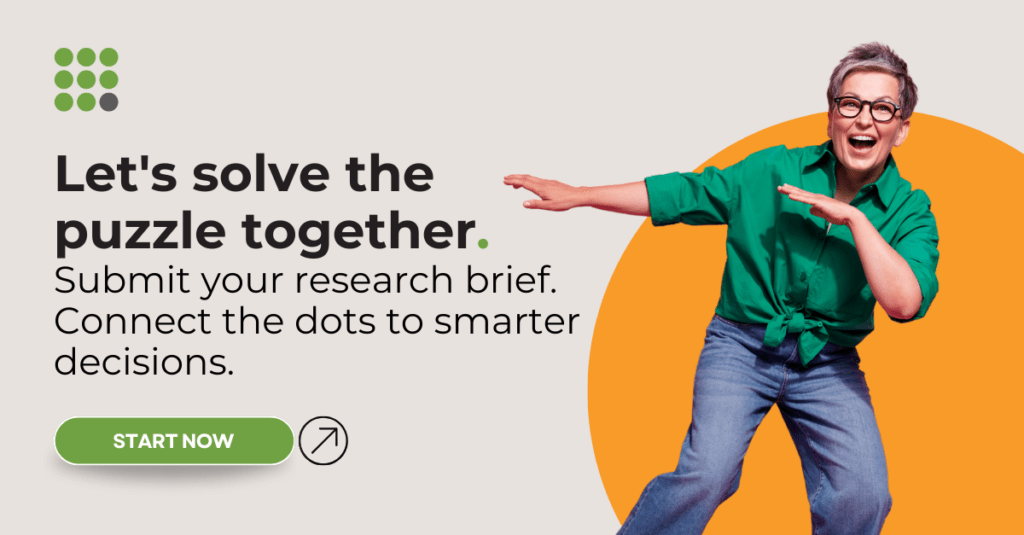In the high-stakes world of product development, even the most brilliant ideas can fall flat without proper validation. Enter concept testing—a powerful tool that helps brands bridge the gap between imagination and market reality. Concept testing is a critical checkpoint where innovative ideas face their toughest judges: consumers. By gauging real consumer reactions before committing substantial resources to development, brands can refine product features, tailor messaging, and ensure their vision aligns with market demands.
But why is this process so vital? Research shows that 95% of new products fail to meet their creators’ expectations, and concept testing offers a lifeline, turning potential disasters into market hits. The ability to course-correct based on genuine feedback often separates successful product launches from costly missteps.
Key Benefits of Concept Testing
Concept testing goes beyond simply gauging consumer interest—it is a comprehensive tool that enables brands to fine-tune product features, enhance messaging, and reduce risks through advanced analytics and consumer insights.
1. Refining Product Features with Data-Driven Insights
Concept testing allows brands to gather precise consumer feedback on product features before large-scale development. Using predictive analytics and latent class analysis, brands can identify which product features are most important to specific consumer segments, tailoring their offerings to meet market demand.
2. Tailoring Messaging with Psychographic Precision
A compelling product alone isn’t enough. Messaging must resonate emotionally with the target audience. Advanced concept testing techniques such as conjoint analysis and sentiment analysis allow brands to evaluate how well their messaging connects with consumers. This helps identify emotional triggers that drive purchasing decisions.
3. Reducing Risk Through Predictive Analytics and Agile Iteration
One of the most valuable aspects of concept testing is its ability to function as a predictive risk management tool. By conducting A/B tests and simulated market environments, brands can model how products will perform across various market segments and conditions, significantly reducing the likelihood of failure.
Concept Testing Successes
Case Study: Yamaha – Crafting the Perfect User Experience
Image Source: Yamaha Website
Challenge
Yamaha, a global leader in musical instrument manufacturing, was deciding between two user control mechanisms—a knob or a sliding fader—for their new electric keyboard. Unsure which option would resonate with musicians, Yamaha turned to their target audience for direct feedback.
Concept Testing Outcome
Yamaha gathered valuable insights into user preferences by conducting focus groups and surveys with musicians. Musicians overwhelmingly favoured the sliding fader, citing its precision and ease of use, particularly for live performances. Younger, tech-savvy users also found the fader more intuitive and aesthetically pleasing.
Results
Yamaha incorporated the sliding fader into the keyboard’s final design, which received wide acclaim upon its release. This case study underscores how involving consumers early in the design process can lead to more successful product outcomes and stronger consumer-brand connections.
Case Study: Everipe – Unlocking Market Potential Through Concept Testing
Image Source: Hunterand
Background:
Everipe, a brand specialising in healthy superfood smoothie kits, faced a significant challenge when developing a new product line. While working closely with manufacturers to refine the product, they struggled to align the final product with their long-term vision and the anecdotal feedback they received from initial product samplers. This uncertainty made it difficult to know whether the product would stand out in a crowded market of similar health-conscious offerings.
Challenge:
Kerry Roberts, co-founder of Everipe, realised that they were constantly working with the manufacturer and iterating on the product. They were struggling to bridge the gap between the product, their broader vision, and the anecdotal feedback they received from people who sampled it. Everipe needed a data-driven solution to validate its product concept and determine how it compared to competitors in the superfood smoothie category.
That’s when Everipe turned to concept testing and benchmarking. The goal was to gauge consumer interest and benchmark their upcoming product line against dominant competitors in the market.
Why It Succeeded:
As a result of concept testing, Everripe was able to:
- Validate Product Appeal: Through data-backed concept testing, Everipe confirmed its product resonated strongly with its target market, identifying key areas where it had a competitive advantage.
- Refine the Product Line: The feedback collected helped Everipe make informed decisions about product features and positioning, bridging the gap between their internal vision and what consumers truly wanted.
- Benchmark Against Competitors: Everipe could compare its product with the leading brands in the market, providing a clear view of where it stood and what differentiating factors it could leverage.
Everipe used data-driven concept validation to turn uncertainty into opportunity, ensuring their new product line resonated with consumers and stood out in a crowded market.
Concept Testing Failures
Case Study: Juicero – When High-Tech Innovation Misses the Mark
Image Source; Arstechnica
Background:
Launched in 2016, Juicero was positioned as the “Apple of Juicers,” a revolutionary Silicon Valley startup aiming to transform how people consume fresh fruits and vegetables. The brand attracted significant investment from top venture capital firms, raising over $120 million in funding. Juicero’s differentiator was its high-tech design—a Wi-Fi-enabled juicer paired with proprietary juice packs and a mobile app controlling juicing operations. The juicer even refused to operate if a pack had expired, theoretically ensuring a premium, hassle-free juicing experience.
However, Juicero entered the market at $699, later reduced to $399, with individual juice packs costing between $5 and $8. Despite the sleek design and technological prowess, Juicero’s ultimate downfall lay in a fundamental disconnect between its features and consumers’ needs.
Challenge:
While Juicero touted its innovation, the company failed to thoroughly validate whether there was real consumer demand for such a high-tech and complicated juicing experience. Concept testing and iterative validation could have revealed several key missteps in the product’s design and pricing strategy:
- Overcomplication: Juicero’s technology, including Wi-Fi connectivity and pack expiration tracking, created an unnecessarily complex experience for what should have been a simple, health-focused product. Consumers didn’t need such advanced features to get fresh juice, and many found the high price unjustified.
- Price vs. Value Mismatch: The product was perceived as too expensive, at $699 (later $399) for the machine and $5-8 for individual juice packs. Most customers were unwilling to pay such a premium when cheaper and simpler options existed.
- Limited Utility: Juicero required its proprietary packs to operate, restricting consumer choice and adding ongoing costs. As with the failed Keurig 2.0 machine, which only worked with Keurig-approved coffee pods, this product control alienated customers.
Why It Failed:
Juicero’s downfall became evident when Bloomberg posted a video demonstrating consumers could simply squeeze the juice packs by hand—without the expensive machine—and achieve the same results. This revelation dealt a fatal blow to the product’s perceived value, as it illustrated that Juicero’s complex, expensive technology was unnecessary for the product’s core function: extracting juice.
In the aftermath, Juicero faced widespread public criticism, and consumer trust in the brand evaporated. The company was forced to offer refunds to customers and ultimately ceased operations in 2017, just a year after its launch.
Key Reasons for Failure:
- Lack of Iterative Concept Validation: Juicero didn’t properly test its product with target consumers, failing to learn that the complexity and high cost outweighed the perceived value.
- Over-engineered Solution: The machine’s advanced features were unnecessary, and consumers did not see them as beneficial. Simpler, cheaper alternatives were available.
- Unfavourable Market Perception: Once it became clear the machine’s primary function could be replicated by hand, Juicero lost its credibility and failed to recover from the negative press.
Understanding customer needs, market demand, and potential pitfalls could have saved Juicero from becoming one of Silicon Valley’s most notorious product flops.
Case Study: Dove’s Body-Shaped Bottles – When Well-Intentioned Ideas Go Awry
Image Source: YouTube
Background:
In 2017, Dove, a brand known for its body positivity and inclusive messaging, introduced a limited-edition line of shampoo bottles shaped like different female body types. The idea behind this initiative was in line with Dove’s long-standing mission to celebrate beauty in all shapes and sizes, and the bottles were intended to represent inclusivity.
However, instead of being celebrated, the initiative was widely criticised as “tone-deaf,” with many consumers accusing the brand of reinforcing the very body-image issues it sought to address.
Challenge:
Dove conducted a concept testing survey before the launch of the bottles. Their research found that slimmer, human-shaped bottles appealed more to audiences than wider bottles. While this feedback influenced the product design, Dove missed a crucial opportunity to dive deeper into the broader cultural context of their messaging.
The campaign’s execution, however, failed to consider the potential negative perceptions consumers might associate with packaging that drew such direct comparisons between body types and product design. The public backlash suggested consumers felt uncomfortable seeing their body types compared to shampoo bottles, highlighting a misalignment between the brand’s values and the campaign’s message.
Why It Failed:
Despite initial concept testing, the Dove body-shaped bottles failed due to a lack of iterative testing and a disconnect between the concept and its execution. Dove’s initial research focused on visual appeal but did not consider the broader cultural and emotional context. By the time the bottles hit the shelves, it was clear the packaging undermined Dove’s previous campaigns, which had championed body positivity without objectifying women’s bodies.
Had Dove employed continuous, iterative concept validation throughout the design process, they might have spotted the cultural disconnect earlier. Testing the bottles at multiple stages of development would have allowed the brand to gauge consumer sentiment more thoroughly, giving them a chance to adjust their strategy before launch.
Key Reasons for Failure:
- Lack of Iterative Testing: Dove’s concept validation occurred early in the design process, but further testing was not conducted as the project evolved.
- Cultural Disconnect: Despite their positive intentions, the brand underestimated how the comparison between body shapes and product packaging could be perceived as offensive.
- Failure to Align with Brand Values: Dove’s execution clashed with their previously successful campaigns that celebrated body positivity without objectifying women.
This case highlights the importance of ongoing concept testing reflecting real-time cultural beliefs. Testing concepts at multiple stages of development and ensuring alignment with brand values can help avoid reinforcing unintended negative messages, even if those messages are well-intentioned.
How to Implement Concept Testing Successfully
Implementing concept testing effectively goes beyond simply gathering feedback—it requires a strategic, well-structured approach that aligns with a brand’s overarching goals. So how can brands extract maximum value from concept testing?
1. Target Audience Selection: Testing the Right Consumers
The foundation of a successful concept test lies in selecting the right audience. This involves segmenting consumers not just demographically but also psychographically. In advanced concept testing, brands can use behavioural segmentation to target consumers based on their buying habits, lifestyle choices, and brand affinities. The more accurately a brand can identify its target audience, the more actionable the feedback becomes. This ensures the insights gathered reflect the needs and preferences of the consumers who purchase the product.
Example:
Brands entering new markets must select a representative sample of the local consumer base. Companies often use multi-market testing platforms to segment their audience by geography and cultural context, ensuring that the feedback they receive is relevant to each unique market. This is particularly important for global brands launching products across different regions.
2. Testing Methods: Choosing the Right Tools
There are several methodologies brands can adopt for concept testing, each offering different insights depending on the product and target market. Some of the most effective concept testing methods include:
- Surveys: Collect quantitative data from a large sample to identify overall trends in consumer preferences.
- Focus Groups: A qualitative approach that allows brands to dive deep into consumer perceptions and emotional reactions to product concepts.
- Online Testing Platforms: Digital testing environments allow brands to conduct A/B testing and gather real-time feedback, enabling faster iterations of product development.
Brands with advanced testing capabilities are now leveraging conjoint analysis—a statistical technique that helps determine how consumers value different features in a product. This type of testing allows brands to identify the optimal combination of features that will drive market success.
Example:
An online retailer looking to launch a new product line may use A/B testing on its e-commerce site. By presenting different product descriptions, pricing options, or visuals to different consumer groups, the brand can determine which combination yields the highest engagement and purchase intent. This reduces the guesswork involved in product development.
3. Data Analysis: Turning Feedback into Actionable Insights
Once the data is collected, brands must transform raw consumer feedback into actionable insights. Advanced data analytics tools are instrumental in this process. Many companies use machine learning algorithms to identify patterns and predict how products will perform across different segments. This allows brands to adjust product features or marketing strategies with a higher degree of confidence.
Text analysis tools help companies analyze qualitative feedback from open-ended survey questions, focus groups, and social media responses. By categorising consumer sentiments and identifying key pain points, brands can make data-driven decisions that reflect real consumer needs.
Example:
Imagine a consumer electronics company planning to launch a new smartphone. Using predictive analytics during the concept testing, they can model how various feature combinations (such as screen size, battery life, and camera quality) will perform across different consumer demographics. This analysis helps the company tailor the product to maximise appeal, ensuring a higher likelihood of success.
4. Refining Strategy: Agile Testing for Continuous Improvement
Concept testing isn’t a one-time activity. The most successful brands use an agile testing approach, continuously gathering feedback, refining, and testing again. This iterative process helps brands stay responsive to market shifts and consumer preferences, ensuring the final product is relevant when it launches and adaptable to future trends.
Example:
Brands in the tech sector frequently use agile testing to adapt to rapidly changing consumer expectations. For instance, a software company might test different versions of a product feature with select user groups before committing to full development. This agile approach allows quick adjustments and ensures the final product is market-ready.
Emerging Trends in Concept Testing
Concept testing is constantly evolving, driven by technological advancements and shifting consumer behaviours. Forward-thinking brands must stay aware of the latest trends to optimise their product development processes and maintain a competitive edge.
Here are some of the most notable emerging trends in concept testing:
1. AI and Machine Learning for Deeper Insights
While concept testing has always relied on data analysis, integrating AI and machine learning takes it to the next level. These tools enable brands to process large datasets more quickly and uncover subtle patterns in consumer preferences that would otherwise be missed. With AI-driven algorithms, brands can predict consumer reactions and long-term product performance trends, helping them stay ahead of the curve.
How to leverage: Brands should adopt AI-powered platforms to enhance their data analysis capabilities. This will make pinpointing key product features or messaging strategies that resonate with different segments easier.
2. Real-Time Feedback and Agile Iteration
The traditional concept testing model involved delayed feedback loops, but modern platforms now allow real-time consumer feedback. This shift enables brands to adjust on the fly, refining product features, design, or messaging more rapidly than ever before. In fast-moving markets, where consumer preferences can shift overnight, real-time feedback ensures products remain relevant throughout development.
How to leverage: Implement agile testing platforms that provide instant feedback from target consumers, enabling swift iterations and minimising time to market.
3. Cross-Cultural Testing and Globalisation
As brands expand into international markets, cross-cultural testing has become a necessity. Global brands must ensure their products and messaging resonate with diverse consumer bases. What works in one country might not work in another, so localised concept testing helps brands tailor their offerings to suit regional preferences, cultural nuances, and consumption habits.
How to leverage: Incorporate localised testing phases early in the product development cycle, ensuring products are culturally adaptable and resonate with specific regional needs.
4. Virtual and Augmented Reality for Immersive Testing
Virtual reality and augmented reality are opening new frontiers in concept testing, particularly in retail, home improvement, and real estate industries. These tools allow consumers to experience products in a simulated environment, providing deeper qualitative insights that static surveys or focus groups cannot achieve. Immersive experiences allow brands to gather feedback on user interactions, spatial preferences, and product design more dynamically.
How to leverage: Brands, particularly in visually driven industries, should explore VR and AR testing environments to create immersive product experiences for their consumers, leading to more informed product development decisions.
5. Sustainability as a Core Testing Focus
With environmental consciousness on the rise, sustainability has become a key factor in consumer decision-making. Concept testing now often includes assessing how a product’s environmental footprint influences purchase behaviour. Consumers want products that align with their values and are increasingly seeking eco-friendly options. This shift forces brands to test not just a product’s functionality but also its sustainability credentials.
How to leverage: Incorporate sustainability metrics into concept testing, assessing how packaging, sourcing, and product lifecycle impact consumer choices.
6. Enhanced Collaboration Across Teams
As concept testing becomes more sophisticated, so does the need for cross-functional collaboration. Marketing, product development, R&D, and data science teams must work in tandem to interpret consumer feedback and refine products accordingly. A well-integrated team can act on insights more efficiently, ensuring product iterations are cohesive and aligned with broader business goals.
How to leverage: Foster collaboration between cross-functional teams to ensure a holistic approach to product development, from concept testing to final market launch.
7. Competitive Benchmarking Using Concept Testing
Brands increasingly use concept testing to validate internal ideas and benchmark their products against competitors. This process helps identify market gaps or opportunities where a brand can differentiate itself. Competitive benchmarking ensures a product isn’t just good—it’s better than what’s already available.
How to leverage: Use benchmarking techniques during concept testing to measure how your product performs in relation to direct competitors and identify areas for differentiation.
Staying Ahead with Emerging Trends in Concept Testing
As concept testing evolves, brands that stay ahead by adopting these trends will find themselves better equipped to navigate the complex world of product development. Incorporating AI, real-time feedback, global testing, and sustainability as core aspects of the testing process will ensure brands remain agile, adaptable, and in sync with their target audiences.
Partner with Us for Cutting-Edge Concept Testing
At Kadence, we specialise in bringing these emerging trends to life for brands across Asian and Western markets. Our concept testing solutions are designed to ensure your products succeed. Contact us today to learn how we can help you navigate the future of concept testing and achieve lasting market success.




 Senior Marketing Executive
Senior Marketing Executive Sales & Marketing
Sales & Marketing General Manager PR -Internal Communications & Government Affairs
General Manager PR -Internal Communications & Government Affairs Vital Strategies
Vital Strategies
 Customer Intelligence Director
Customer Intelligence Director